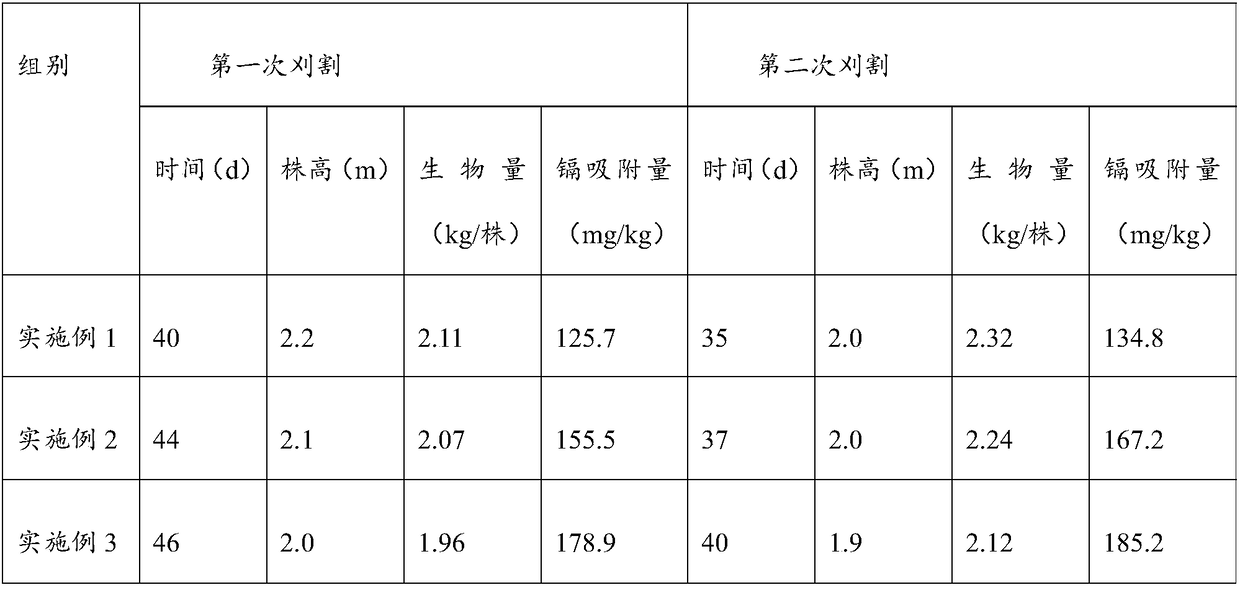Method for restoring soil heavy metal cadmium pollution
A technology for remediation of soil and heavy metals, applied in the field of remediation of heavy metal cadmium pollution in soil, can solve problems such as weak soil remediation ability, slow growth rate, application limitation, etc., and achieve the effects of accelerating restoration, rapid growth, and releasing growth inhibition.
- Summary
- Abstract
- Description
- Claims
- Application Information
AI Technical Summary
Problems solved by technology
Method used
Image
Examples
Embodiment 1
[0033] A method for remediating soil heavy metal cadmium pollution, said method comprising the following steps:
[0034] a. Choose the land free of heavy metal cadmium pollution as the seedling base of grain amaranth.
[0035] b. Before sowing, trim the land, apply sufficient base fertilizer, and drill the seeds of amaranth seeds with a row spacing of 50-60 cm, shallow ditching, shallow covering soil, and a plant-to-plant spacing of 15 cm.
[0036] c, grain amaranth takes root and germinates, grows into seedlings and continues to cultivate, after it grows to 20 leaf ages, the root length of grain amaranth is regularly sampled, and when its main root grows to 7cm, its aerial part is mowed and reserved 1 functional leaf and removed from the seedling base with a small amount of soil on the root.
[0037] d. Select the soil with a soil cadmium concentration of 20 mg / kg as the soil to be repaired, open holes on it, plant the grain amaranth removed from step c, and continue to cult...
Embodiment 2
[0041] A method for remediating soil heavy metal cadmium pollution, said method comprising the following steps:
[0042] a. Choose the land free of heavy metal cadmium pollution as the seedling base of grain amaranth.
[0043] b. Before sowing, trim the land, apply sufficient base fertilizer, and drill the seeds of amaranth seeds with a row spacing of 50-60 cm, shallow ditching, shallow covering soil, and a plant-to-plant spacing of 15 cm.
[0044] c, grain amaranth takes root and germinates, grows into seedlings and continues to cultivate, after it grows to 20 leaf ages, the root length of grain amaranth is regularly sampled, and when its main root grows to 7cm, its aerial part is mowed and reserved 1 functional leaf and removed from the seedling base with a small amount of soil on the root.
[0045] d. Select the soil with a soil cadmium concentration of 30 mg / kg as the soil to be repaired, open holes on it, plant the grain amaranth removed from step c, and continue to cultiv...
Embodiment 3
[0049] A method for remediating soil heavy metal cadmium pollution, said method comprising the following steps:
[0050] a. Choose the land free of heavy metal cadmium pollution as the seedling base of grain amaranth.
[0051] b. Before sowing, trim the land, apply sufficient base fertilizer, and drill the seeds of amaranth seeds with a row spacing of 50-60 cm, shallow ditching, shallow covering soil, and a plant-to-plant spacing of 15 cm.
[0052] c, grain amaranth takes root and germinates, grows into seedlings and continues to cultivate, after it grows to 20 leaf ages, the root length of grain amaranth is regularly sampled, and when its main root grows to 7cm, its aerial part is mowed and reserved 1 functional leaf and removed from the seedling base with a small amount of soil on the root.
[0053] d. Select the soil whose cadmium concentration is 40mg / kg as the soil to be repaired, open a hole on it, plant the grain amaranth removed from step c, and continue to cultivate....
PUM
 Login to View More
Login to View More Abstract
Description
Claims
Application Information
 Login to View More
Login to View More - R&D
- Intellectual Property
- Life Sciences
- Materials
- Tech Scout
- Unparalleled Data Quality
- Higher Quality Content
- 60% Fewer Hallucinations
Browse by: Latest US Patents, China's latest patents, Technical Efficacy Thesaurus, Application Domain, Technology Topic, Popular Technical Reports.
© 2025 PatSnap. All rights reserved.Legal|Privacy policy|Modern Slavery Act Transparency Statement|Sitemap|About US| Contact US: help@patsnap.com


